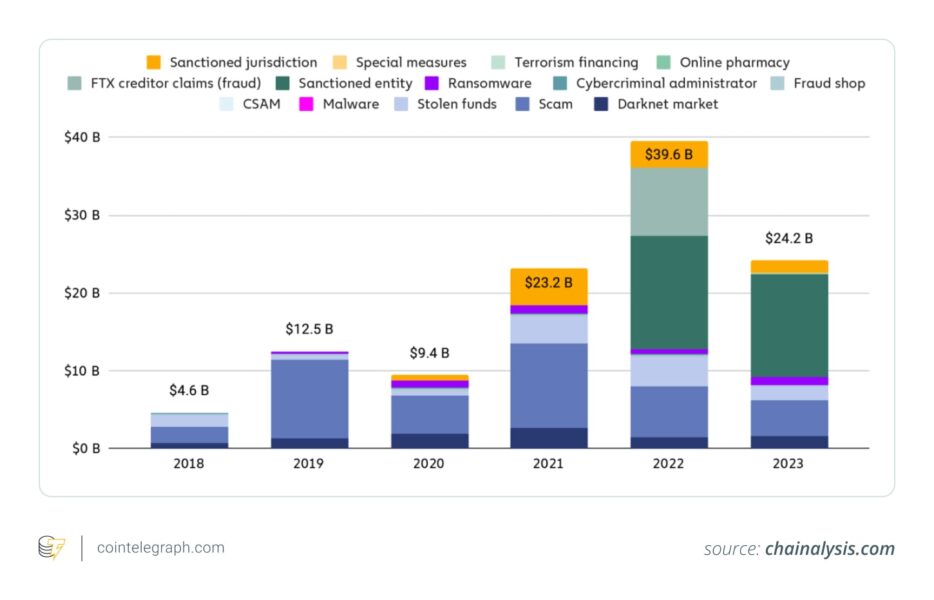What does the seizure of cryptocurrency mean?
Seizure of cryptocurrency refers to the confiscation of crypto assets by authorities, usually as part of legal investigations. It may occur in cases of fraud, money laundering or other unlawful activities.
If law enforcement agencies suspect illicit activity, they can confiscate digital assets from wallets. The funds are usually transferred to government-controlled wallets until the conclusion of the judicial process. The seized assets are sold or auctioned if the accused is convicted in court. But if they are found innocent, the cryptocurrency is returned to their wallet.
A seizure takes place during an arrest, under a search warrant, or with a seizure warrant that specifically identifies the property to be confiscated. Seizure warrants for cryptocurrencies are usually issued to exchanges or other institutional custodians, not individuals.
The warrant will specify the exchange’s wallet address and the reasons for the seizure. The exchange will be directed to provide the private keys for the specific wallet to the prosecuting agency. To avoid any liability and the possibility of facing severe consequences, the exchange usually complies and shares the private keys.
Still, the requirement for exchanges to relinquish private keys under legal duress poses a fundamental challenge to the decentralized ethos that cryptocurrencies were built upon.
Notably, a warrant is not the only way for a law enforcement agency to seize cryptocurrencies like Bitcoin held by another individual or entity. Cryptocurrency can also be taken by the government through a process called forfeiture. Forfeiture refers to the permanent loss of an asset as mandated by a court order or judgment. Crypto seizures generally happen before forfeiture, and not all seized assets are forfeited.
Did you know? In Nov. 2023, the Department of Justice (DOJ) seized nearly $9 million worth of Tether. These funds were traced to cryptocurrency addresses allegedly associated with pig butchering scams.
What is the process of seizing cryptocurrency?
The process of seizing crypto differs from the procedure authorities follow for confiscating physical assets like apartments, vehicles or jewelry. Tangible objects can be taken away using physical force, but when it comes to a crypto wallet, the corresponding private key is needed to unlock and transfer the funds.
Authorities often collaborate with the exchange hosting the wallet to access and recover funds. This works well with software wallets, also called hot wallets, as exchanges usually have a copy of the key. For hardware wallets or cold wallets, which are offline and privately owned, authorities may need to hack into the device to recover funds.
After a seizure, authorities secure the cryptocurrency and may liquidate it. A court order is generally required for liquidation, which can take years. After assets are liquidated, the proceeds are either given to crime victims or split among government agencies.
The Department of Justice (DOJ) in the US set up the Virtual Asset Exploitation Unit (VAXU) within the Federal Bureau of Investigation (FBI) in 2022 to focus on blockchain analysis and virtual asset seizure. VAXU works closely with the DOJ’s National Cryptocurrency Enforcement Team (NCET) in seizure matters.
In some cases, government agencies use a process called administrative forfeiture. In such procedures, the government seizes assets without charging the wallet holders with a crime. This means without a court hearing, you may end up losing your crypto.
In a related context, the FBI launched NexFundAI, a cryptocurrency token created in May 2024, as part of Operation Token Mirrors. This covert sting operation aimed to target individuals and organizations involved in fraudulent cryptocurrency activities, particularly pump-and-dump schemes. Designed to mimic a legitimate cryptocurrency, NexFundAI served as bait to attract market manipulators, allowing the FBI to gather evidence against them.
Did you know? A Chainalysis report revealed that criminals used DeFi protocols to launder 17% of all funds sent from illicit wallets in 2021, up from 2% in 2020.
When are crypto assets seized?
Authorities seize cryptocurrency when it’s used for illicit activities such as tax evasion, money laundering, fraud or drug trafficking.
If someone is using crypto for illegal activities, such as narcotics or hacking, it may result in the crypto being deemed by authorities as ‘proceeds of a crime,’ making it subject to seizure by government agencies. The objective of the seizure is to thwart illegal activity or retrieve stolen money.
Criminals use cryptocurrency to take advantage of “anonymous” transactions on blockchains and conceal the movement of their funds. Still, government agencies can identify the proceeds of crime through the data breadcrumbs left on the blockchain and confiscate the funds. They can also request that crypto exchanges freeze the wallets used for committing crimes.
Prosecutors consider the logistics of seizing crypto assets, potential forfeiture or management challenges and the asset’s value when deciding whether to proceed with seizures.

What happens after the seizure of crypto?
In the US, after the funds belonging to you are seized under civil laws, you need to retain an asset forfeiture attorney to file a verified claim with the seizing agency for court action. The agency has a 90-day deadline to file a complaint for forfeiture of the funds or return the cryptocurrency.
When the agency files a complaint for forfeiture, the court issues a notice to all parties involved to present their case. Your attorney can file the answer, counterclaim and motion to dismiss the agency’s complaint. If you establish your case, the court may dismiss the agency’s case against you and order it to pay your attorney fees along with returning the seized crypto assets.
If the agency has filed a criminal case against you, the procedure may be more complex and you’ll need to defend other charges as well. In such cases, defendants often accept plea deals, which can eliminate the need for a seizure warrant. In these cases, defendants may voluntarily surrender private keys as part of a plea agreement.
In the UK, the Proceeds of Crime Act 2002 outlines how seized cryptocurrencies should be handled. Similar to other confiscated assets, 50% goes to the Home Office, while the remaining 50% is divided among the police, crown prosecution services and the courts. There’s also the possibility of returning some confiscated assets to victims of crypto crime.
In Europe, when illegal transactions of cryptocurrencies are discovered, authorities seek a court order for freezing or seizure of assets. To implement the order, they work with crypto platforms. In cross-border cases, regulatory agencies such as Europol may offer assistance. The confiscated cryptocurrency is stored in wallets under government control, and depending on the country’s laws, auctions or liquidations may occur after a conviction.
In contrast, Indian law enforcement organizations such as the Enforcement Directorate (ED) and local cybercrime teams work together or separately for the seizure of cryptocurrencies. When illicit activity is discovered, authorities may seek a court order to direct the exchange to freeze or seize the assets. Until a court finally decides the case, confiscated cryptocurrency is kept in wallets under government supervision. The process may involve lengthy investigations, as India is working on clear legal frameworks for handling crypto-related crimes.
Examples of seizure of cryptocurrency
There have been various examples of the seizure of crypto assets by government authorities, including Bitfinex funds, Silk Road and Mt. Gox’s assets.
Here are some well-known examples:
Seizure of Bitfinex funds
In 2022, US federal authorities retrieved about $3.6 billion worth of Bitcoin connected to the 2016 Bitfinex exchange hack. About 120,000 BTC had been taken by hackers, and the money was eventually linked to two people years later.
Authorities seized the assets as part of the investigation. The anonymity of Bitcoin transactions notwithstanding, the case highlighted developments in blockchain analysis by demonstrating that even years-old illicit funds can be located and confiscated.
Did you know? In July 2023, the US Homeland Security recovered $314 million from the 2016 Bitfinex hack and returned it to the victims.
Clampdown on Silk Road
In 2013, the US government confiscated about 144,000 Bitcoin from the online criminal market Silk Road. Ross Ulbricht, the marketplace’s creator, was arrested for facilitating illegal drug transactions. This well-publicized seizure of crypto funds was a component of a more extensive campaign to combat illegal cryptocurrency activity.
The US Marshals Service subsequently put the confiscated Bitcoin, which is currently valued at billions of dollars, up for auction. The Silk Road case continues to be a seminal moment in regulating and prosecuting crimes involving cryptocurrencies.
Confiscation of Mt. Gox’s assets
Mt. Gox, once the biggest Bitcoin exchange, went bankrupt in 2014 after losing 850,000 Bitcoin, worth about $450 million at the time. After filing for bankruptcy, the exchange’s remaining assets, including more than 200,000 BTC, were seized by Japanese authorities. These seized funds were kept in escrow while authorities went through the legal process to pay creditors.
In March 2014, Mt. Gox CEO Mark Karpelès announced the discovery of 200,000 Bitcoin in an old digital wallet, reducing the total loss to 650,000 BTC. This sparked hope for creditors. The Tokyo District Court then appointed a provisional administrator to manage the complex legal case. A major challenge was valuing the lost Bitcoin, as its price had surged since the hack. Karpelès faced charges of embezzlement but was only convicted of falsifying records. In 2024, creditor repayments continued, and the repayment deadline was extended to October 2025.
How do law enforcement agencies use the seized funds?
In the US, federal agencies must submit a plan to the DOJ to use seized funds. This plan outlines how the money will be spent. Civil forfeiture became common in the 1980s during the war on drugs and has faced ongoing criticism ever since.
Sometimes, seized assets are returned to their owners as part of a plea deal. Still, only 1% of seized assets are returned to the owners. Seized funds are often used to support law enforcement operations, like equipment, training and investigations. In 2011, the St. Louis County Police spent $400,000 on helicopter equipment.
While some American states, like Missouri, require seized funds to be allocated to schools, law enforcement agencies often keep most of the money by using the federal Equitable Sharing Program. However, the forceful seizure of assets from individuals or companies has long faced criticism from various quarters.
Many believe that reforms are necessary to ensure that asset forfeiture is conducted fairly and transparently, providing adequate protections for those whose assets are at risk of being seized.
Source: https://cointelegraph.com/explained/what-happens-to-seized-cryptocurrency



